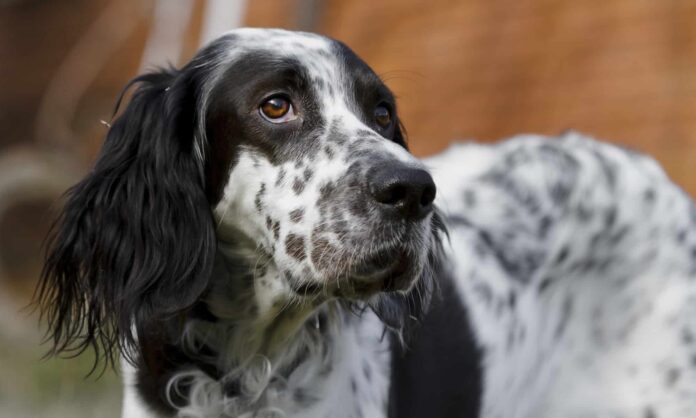Last Updated on October 16, 2023 by Fumipets
The Fascinating History and Characteristics of the Llewellin Setter
The Llewellin Setter is a distinct type of English Setter that is renowned for its hunting and sporting abilities. This breed is known for being active, intelligent, and energetic, with a strong affinity for people and affection.
While often used in hunting, they are also known for their friendly and social nature. They come in various colors, including white and blue Belton.
Llewellin Setter
| Height: | 20-27 inches |
| Weight: | 35-65 pounds |
| Lifespan: | 10-12 years |
| Colors: | Blue, chestnut, lemon, liver, orange, white, black; bicolor, tricolor, Belton |
| Suitable for: | Hunting, active homes, large fenced yards, experienced dog owners |
| Temperament: | Energetic, stubborn, intelligent, mischievous, curious, people-oriented, enthusiastic, gentle |
The Llewellin Setter is a handsome, lively dog that causes debate in the canine community. While some people think these dogs are nothing more than English Setters, others think they are a unique breed of their own. The Llewellin Setters are descended from the dogs Edward Laverack bred. The Llewellin Setter was created by R. Purcell Llewellin via outcrossing Laverack’s top dogs from his breeding program. According to those who think these dogs are English Setters, Llewellin Setters are just one particular breeding line of English Setters.
Whether or not these dogs belong to a specific breed, they make excellent pets, especially in homes with active children or dogs that are used for hunting. They are active dogs who enjoy having a job or particular tasks to complete. They are best for dog owners with experience training stubborn dogs because of their stubborn nature, which can make training them challenging. They are gentle, people-oriented dogs, but their independent spirits can make them complex.
3 Little-Known Facts About Llewellin Setter
1. Llewellin Setter vs English Setter
Many people believe Llewellin Setters are a distinct breed from English Setters because they come from a particular bloodline. Llewellin Setters, however, are eligible for AKC registration as English Setters. Currently, the AKC does not recognize Llewellin Setters. The general consensus is that all English Setters are not Llewellin Setters, but all Llewellin Setters are English Setters.
2. Belton Llewellin Setters
The “Belton” marking pattern is among Llewellin Setters’ most prevalent. Normally born completely white, Belton dogs gradually take on color as they become older. They will exhibit dappling, or ticking, but not noticeable color patches. Bicolor or tricolor Belton markings are possible on orange, chestnut, blue, liver, black, and lemon.
3. Hank the Dog
Hank and his owner Dez are featured in a program on the Outdoor Life Network (OLN) called “Hunting with Hank.” Hank and Dez’s hunting and travel exploits are the main subject of the program. A Llewellin Setter, Hank.

Temperament & Intelligence of the Llewellin Setter
Are These Dogs Good for Families?
Llewellin Setters are great family dogs, particularly in homes with children who are active. They often have a very soft disposition and are quite patient with kids. A Llewellin Setter may be a terrific fit for active families that enjoy sports, hiking, and other outdoor pursuits. A Llewellin Setter needs a fenced yard, everyday playing, and daily walks or runs in households with less extracurricular activities. These dogs do not do well when left alone for long periods of time, so households with children who play a lot of sports or other activities that the dog cannot participate in might not be a good match.
Does This Breed Get Along with Other Pets?
Llewellin Setters should be introduced to small animals with caution, including cats, guinea pigs, birds, reptiles, and even small dogs. Due to their high prey drive, Llewellin Setters may chase or harm smaller animals. They often get along well with other dogs, particularly those that are near in size to them. To ensure that everyone gets along, slow introductions are essential. To assist Llewellin Setter pups develop confidence and trust, this is very crucial.
Things to Know When Owning a Llewellin Setter:
Food & Diet Requirements
Llewellin Setters don’t have any particular dietary requirements, but if your dog engages in regular hunting, sports, or other moderate to vigorous exercise, you should make sure they get enough calories to maintain a healthy weight. Avoid overfeeding, though, since obesity may shorten your dog’s life and put undue pressure on the joints. Advice on what and how much to feed your Llewellin Setter may be obtained from your veterinarian.
Exercise
Your Llewellin Setter needs to be physically active every day. Without enough exercise and socializing, these dogs may develop nervousness, neurosis, and undesirable behavior. Establishing a routine of regular activities you may perform with your dog, such as walks, jogs, sports, and games, will help you two become more trusting of one another and assist your dog get rid of any surplus energy. Have your Llewellin Setter examined by your veterinarian to rule out any underlying medical conditions before considering increasing their daily exercise routine if they start displaying destructive habits, anxiousness, or separation anxiety.
Training
You’ll have to put in some effort to train these pups! They may be quite challenging to teach since they have strong wills and are obstinate. It is not recommended for first-time dog owners or those without prior dog-training expertise to train a Llewellin Setter. Given that these dogs often retain their puppy characteristics throughout their lives, even teaching them basic obedience may be challenging.
Prepare to teach your Llewellin Setter using plenty of positive reinforcement and high value prizes. Find the products or rewards that your dog values the most. This might be a toy, a particular reward or meal, or anything else your dog holds in high regard. Even obstinate dogs may be motivated by high-value prizes, particularly when they understand they won’t get the reward for acting inappropriately. Consistency and persistence are essential while training a Llewellin Setter.
Grooming
Long, straight to wavy hair of Llewellin Setters has to be combed frequently, if not daily, to avoid knots and matting. Dogs who spend a lot of time outside, particularly when hiking or hunting, are more likely to pick up objects like twigs, leaves, burrs, and thorns. To get the coat clean, it could take more work, and certain dogs might even need frequent grooming sessions to keep their skin and hair in good condition.
Health and Conditions
Minor Conditions
Eczema
Skin infections
Allergies
Otitis media (ear infections)
Eye infections/diseases
Serious Conditions
Hip dysplasia
Elbow dysplasia
Juvenile cataracts
Autoimmune thyroiditis/hypothyroidism
Cancer
Congenital deafness
Eosinophilic panosteitis
Male vs Female
Compared to women, men are often more amiable, sociable, and trainable. Females might be more challenging to teach since they seem to have stronger, more independent personalities. They may also be more intellectual than males, making them cunning and well-prepared for hunting. Males are often more tenacious and make for better hunting partners throughout long days in the field.
Conclusion
For those willing to put in the additional work to teach them, Llewellin Setters make wonderful hunting partners. Although they are kind, sociable, and affectionate dogs, they do need more training and care than the ordinary household searching for a companion usually has to provide. Some people think Llewellin Setters are the greatest of the best when it comes to hunting, particularly for birds. They have strong hunting genes bred into them and are motivated.
Make careful to choose a reliable breeder who will provide you with a healthy dog and health assurances when purchasing a Llewellin Setter. Prior to breeding, responsible breeders examine their dogs for hip and elbow health using the OFA/PennHIP system. This lessens the possibility of hip or elbow dysplasia being passed on to the next generation. Look for a reliable breeder or a rescue that can assist match you with the ideal dog. Poorly bred Llewellin Setters may have health issues or behavioral issues that may be challenging to treat or care for.
https://www.youtube.com/watch?v=mar39HKZ1tM
Questions & Answers:
What distinguishes the Llewellin Setter from the English Setter?
The Llewellin Setter is a type of English Setter, but they are distinguished by their specific bloodline and breeding for hunting and field work.
Are Llewellin Setters good family pets?
Llewellin Setters are known for their social and friendly nature, making them suitable for families. However, they require regular exercise and mental stimulation.
What is the typical lifespan of a Llewellin Setter?
Llewellin Setters usually have a lifespan of 10 to 12 years.
Do Llewellin Setters have genetic problems?
While English Setters, including Llewellin Setters, may have some genetic predispositions, it’s essential to research and choose a reputable breeder to minimize potential issues.
Are Llewellin Setters good hunting dogs?
Yes, Llewellin Setters are often bred for hunting and are known for their excellent hunting and sporting abilities, particularly in bird hunting.


















